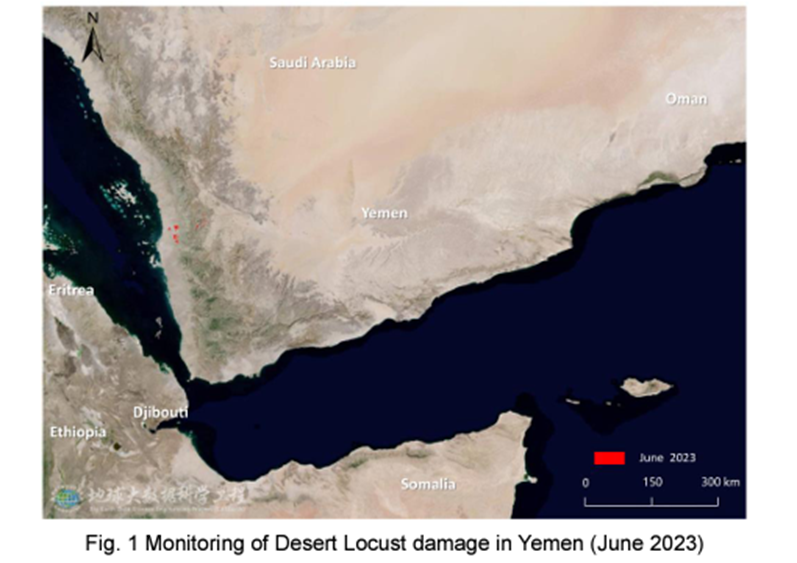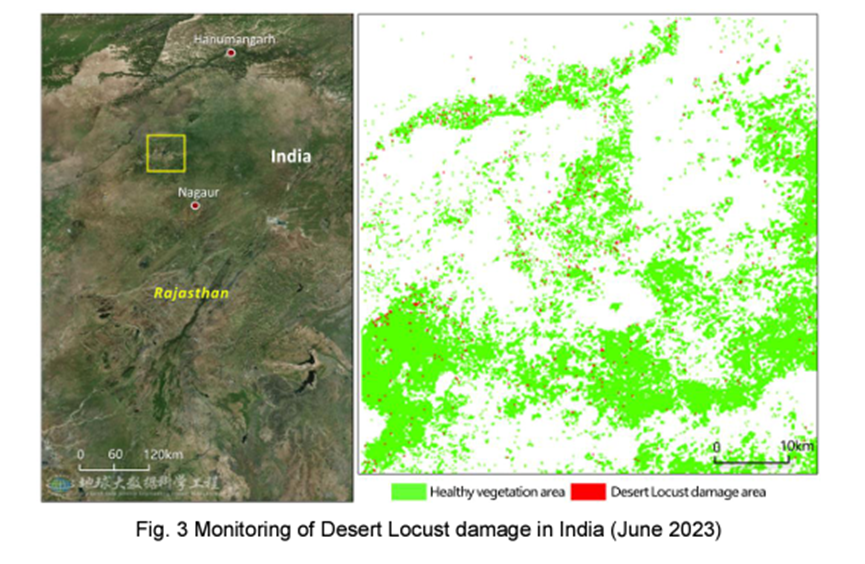No.46 Report of Monitoring and Assessment of Desert Locust in Africa and Asia Issued by Aerospace Information Research Institute and CBCGDF
On July 14, 2023, No.46 Report of Monitoring and Assessment of Desert Locust in Africa and Asia was jointly released by the Team of Prof. Huang Wenjiang, Associate Prof. Dong Yingying from Aerospace Information Research Institute, Chinese Academy of Sciences (CAS) and China Biodiversity Conservation and Green Development Foundation (CBCGDF).

Integrated with multi-source Earth Observation data, e.g., meteorological data, field data, and remote sensing data (such as MODIS in the US, and Sentinel series in EU, etc.), and self-developed models and algorithms for Desert Locust monitoring and forecasting, the research team constructed the ‘Vegetation pests and diseases monitoring and forecasting system’, which could regularly release thematical maps and reports on Desert Locust.
This report focuses on the dynamics of desert locust monitoring and loss assessment in Yemen, Saudi Arabia, and India. The remote sensing monitoring results showed that, in June 2023, the desert locusts were mainly distributed in western and inland regions of Yemen, the western coastal areas and inland regions of Saudi Arabia, as well as northwestern India near the Indo-Pakistan border. The total damaged vegetation areas in Yemen, Saudi Arabia, and India were 24.1, 16.0, and 2.35 thousand hectares, respectively. It is expected that in the next two months, Saudi Arabia will experience high temperatures and dry conditions, while the meteorological conditions in Yemen will be more suitable for the survival of desert locusts. As a result, some locust swarms in Saudi Arabia will migrate southward to the inland areas of Yemen, leading to a decrease in the number of locusts within Saudi Arabia and an increase in the number of locusts in Yemen. Due to the tropical cyclones, the vegetation in northwestern India will gradually increase, providing favorable conditions for the survival of locusts, leading to an increase in the number of locusts. This period is an important growing season for crops in Yemen, and the planting and growing seasons for crops in Saudi Arabia and India. It is still necessary to pay continuous attention to the dynamics of the desert locust disaster in Yemen, Saudi Arabia, and India to prevent losses to agricultural and pasture production.



CBCGDF has always been contributing to this study and the series report aims to help developing countries in Asia and Africa fight invasive species and safeguard food security. The results of the report have been shared with developing countries in Southeast Asia and Africa for free, helping them improve their capability to control the impacts of desert locusts.
[Download the report:]
http://en.rscrop.com/Private/NewsImgs/6382492181159700211119204909.pdf
Original Chinese Article:
https://mp.weixin.qq.com/s/zcVNUobi5GrHOmTpvRT1jw
Translator: Sara
Checked by: Daisy
Editor: Sara
Contact: v10@cbcgdf.org; +8617319454776

Contribution
Do you know? CBCGDF is a non-profit organization. We rely on crowd-funding and donations. You have the opportunity to help us to advance biodiversity conservation. Donate TODAY to power up the movement to make it a better world for all life.



Comments
Post a Comment